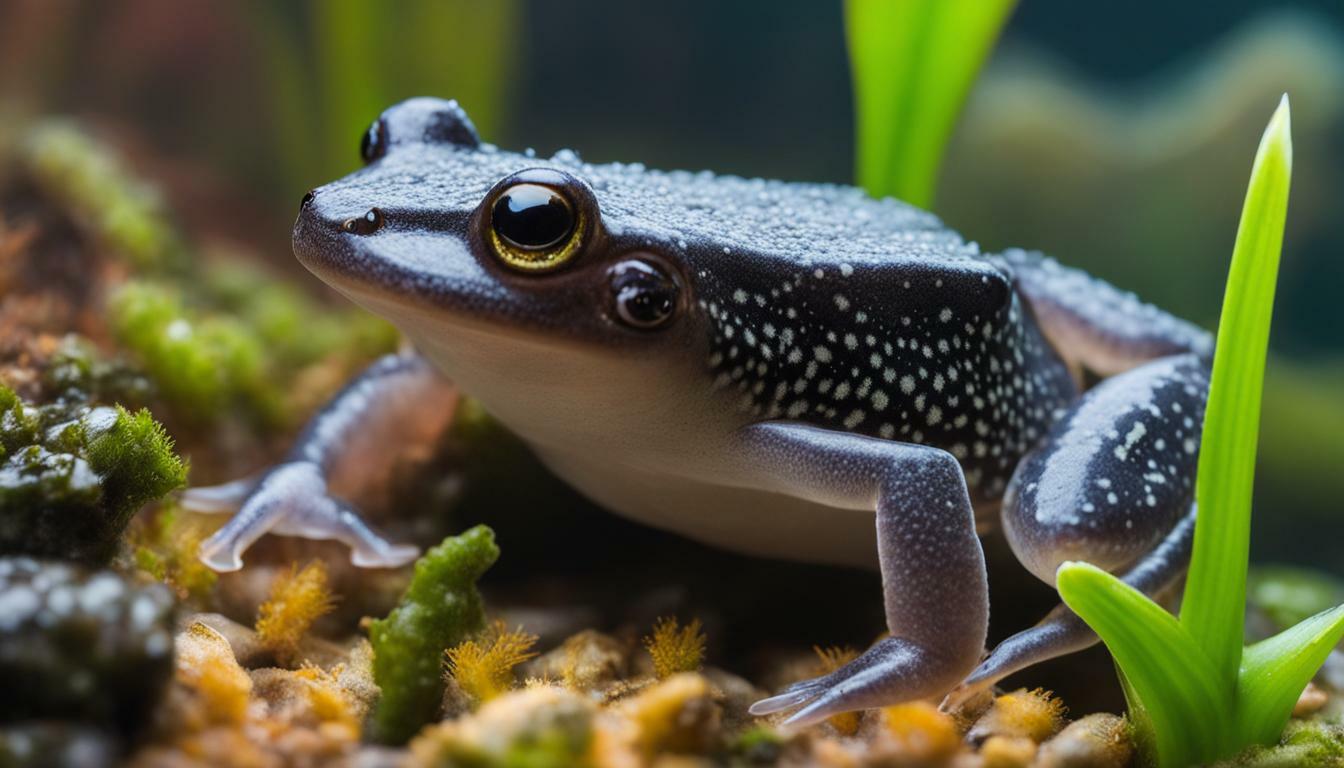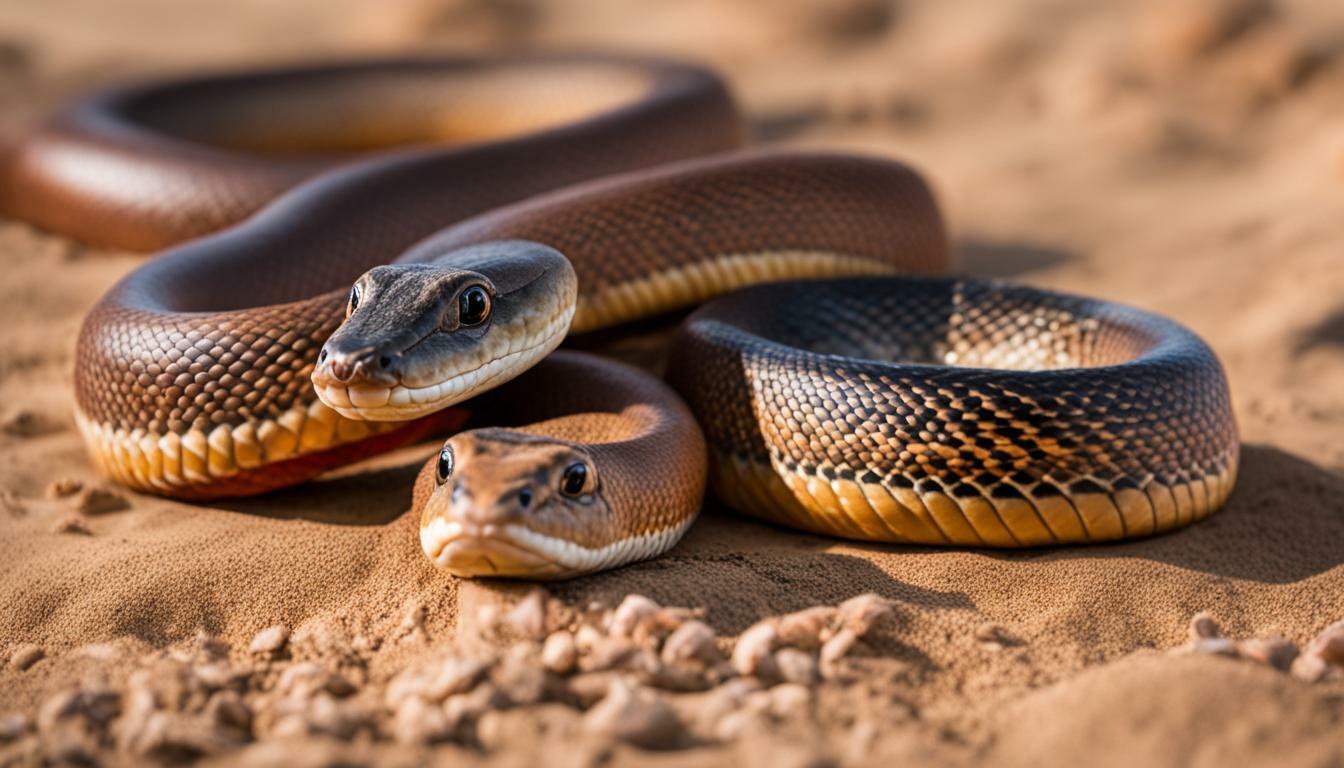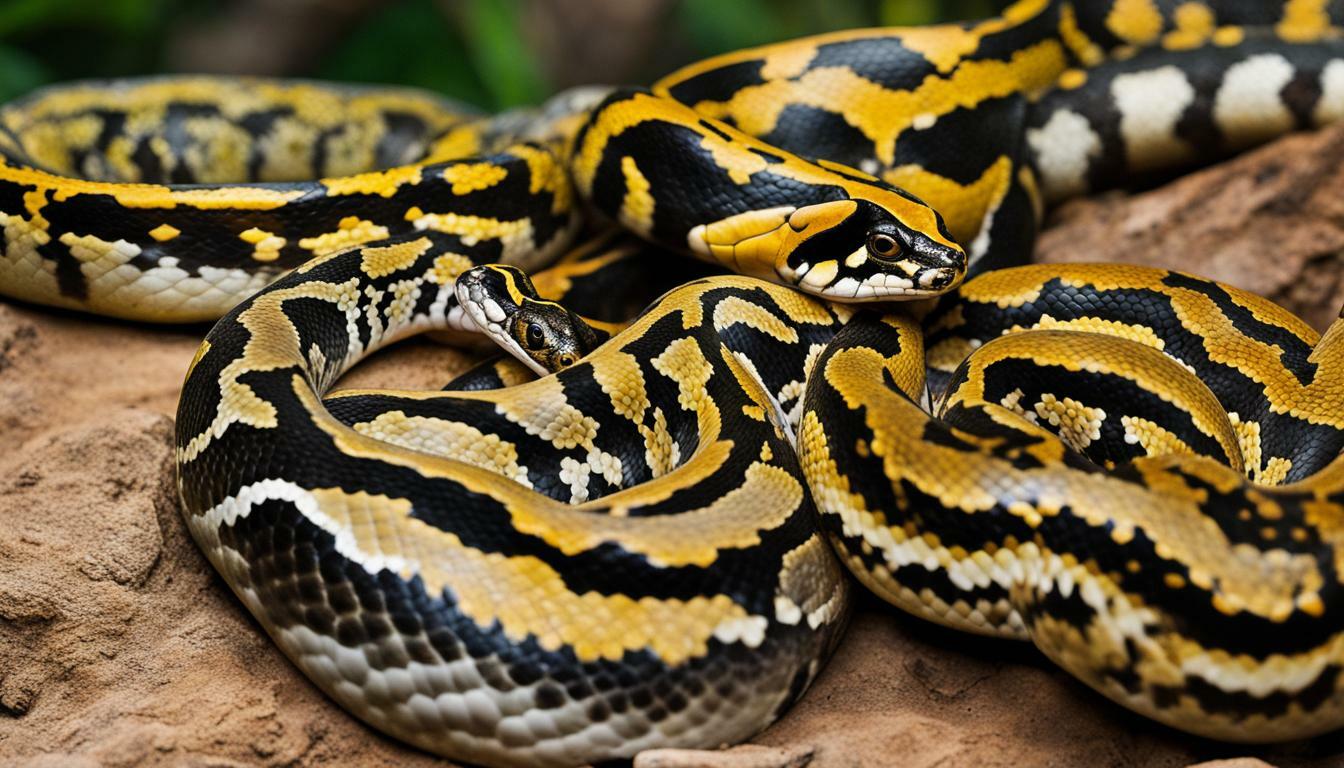Are you interested in learning about aquatic frogs? You may have heard about African Dwarf Frogs and Clawed Frogs, but do you know their differences? In this article, we will explore the unique characteristics, habitats, and behaviors of these two fascinating species.
Key Takeaways:
- African Dwarf Frogs and Clawed Frogs are both aquatic frogs but have distinct differences.
- African Dwarf Frogs are smaller and lack claws on their toes, while Clawed Frogs can grow larger and have powerful claws.
- Both frogs require proper water conditions to survive and have similar diets.
African Dwarf Frogs: Characteristics and Habitat
African Dwarf Frogs (Hymenochirus sp.) are small aquatic frogs known for their cute appearance and vibrant colors. They have flattened bodies, webbed hind feet, and no vocal sacs. These frogs primarily inhabit freshwater environments such as swamps, streams, and rivers in Central and West Africa.
These frogs are popular among pet owners due to their small size, peaceful nature, and low-maintenance needs. Their vibrant colors range from grayish-brown to olive-green, with some having dark spots or stripes. African Dwarf Frogs are nocturnal animals, and they prefer to live in groups and are often seen floating or swimming near the water surface.
Did you know? African Dwarf Frogs are fully aquatic, meaning they do not need to leave the water to survive.
African Dwarf Frogs thrive in a well-maintained habitat with a consistent temperature between 75 and 82 degrees Fahrenheit and a pH level of 6.5 to 7.5. They need clean water and plenty of hiding spaces, such as caves or plants, to feel secure. A filtered and aerated tank with a minimum of 10 gallons of water is optimal for these small aquatic creatures.
African Dwarf Frogs: Behavior
African Dwarf Frogs are fascinating creatures known for their unique behavior. They are generally peaceful and social animals, often seen swimming or floating at the water surface. These nocturnal creatures are most active during the night and tend to eat after the lights are turned off.
One interesting behavior of African Dwarf Frogs is their way of feeding. They use their long tongues to slurp up their food, which primarily consists of small invertebrates and aquatic plants. Additionally, these frogs are known for their ability to hold their breath for extended periods due to their high tolerance for low oxygen levels in their natural habitat.
It is important to note that African Dwarf Frogs are sensitive to water pollutants and changes in water temperature. Therefore, it’s crucial to maintain proper water conditions in their aquariums to ensure their long-term health and well-being.
Overall, African Dwarf Frogs are fascinating creatures to observe, and their unique behavior adds charm to any aquatic environment.
Clawed Frogs: Characteristics and Habitat
Clawed Frogs (Xenopus sp.) are fascinating amphibians with unique characteristics and habitats. These frogs have robust bodies and distinctive claws on their toes, which set them apart from other frog species. They come in various colors, including shades of brown, green, and gray, and can grow up to 5 inches in length.
Clawed Frogs are native to sub-Saharan Africa and can be found in a wide range of habitats. They prefer freshwater environments such as rivers, streams, and ponds, but can also be found in temporary water bodies like puddles and ditches. Clawed Frogs have a unique ability to tolerate a range of water conditions, including those that are slightly saline or alkaline.
These frogs have a varied diet and are known to eat a wide range of prey. They primarily feed on small invertebrates such as insects, crustaceans, and snails, but can also consume small fish and tadpoles. Clawed Frogs have a lifespan of around 10 to 15 years in captivity, making them a popular choice among amphibian enthusiasts.
Clawed Frogs: Behavior
Clawed Frogs are known for their fascinating behavior. They are highly adaptable and can burrow into the substrate or hide in vegetation. They are voracious eaters and will consume a wide range of prey, including insects, small fish, and tadpoles. Clawed Frogs are also known for their ability to regenerate damaged or lost limbs.
“Clawed Frogs are fascinating creatures due to their regenerative capabilities. They are able to regrow limbs, which is a rare and unique characteristic among amphibians.”
Clawed Frogs are also known for their unique vocalizations. They have a distinctive, deep call that can be heard from quite a distance. During mating season, males will produce a series of short, pulsating calls to attract females. They will also engage in physical combat with other males for the attention of a female.
Another interesting behavior of Clawed Frogs is their ability to tolerate dry conditions. When their aquatic habitat dries up, they will burrow underground and enter a state of dormancy until the water returns. This unique adaptation allows them to survive in some of the harshest environments in Africa.
Similarities Between African Dwarf Frogs and Clawed Frogs
Despite being different frog species, African Dwarf Frogs and Clawed Frogs share some similarities. Here are some of their common traits:
| African Dwarf Frogs | Clawed Frogs |
|---|---|
| Both species are aquatic frogs and require proper water conditions to survive. | They are also aquatic and can be found in freshwater and temporary water bodies. |
| They have similar diets, feeding on small invertebrates and aquatic plants. | Clawed Frogs are known to be voracious eaters, consuming a wide range of prey, including insects, small fish, and tadpoles. |
| Both frogs have a lifespan of around 5 to 10 years in captivity. | They can also live up to 10 years in captivity. |
These similarities show that, despite their differences, African Dwarf Frogs and Clawed Frogs are both fascinating aquatic creatures worth exploring.
Differences Between African Dwarf Frogs and Clawed Frogs
African Dwarf Frogs and Clawed Frogs are two distinct species of aquatic frogs that share certain similarities, but have several differences that set them apart.
| Characteristic | African Dwarf Frogs | Clawed Frogs |
|---|---|---|
| Size | Maximum of 2 inches | Can grow up to 5 inches |
| Toe Claws | No claws on toes | Powerful claws for digging and defense |
| Habitat | Primarily in freshwater habitats | Found in both freshwater and temporary water bodies |
| Behavior | Peaceful and social creatures that prefer to live in groups; nocturnal and most active during the night; consume food by slurping it up with their long tongues | Voracious eaters that consume a wide range of prey; highly adaptable and can burrow into the substrate or hide in vegetation; known for their ability to regenerate damaged or lost limbs |
In summary, African Dwarf Frogs are smaller in size and lack claws on their toes, while Clawed Frogs are larger and have powerful claws for digging and defense. African Dwarf Frogs primarily inhabit freshwater habitats, while Clawed Frogs can be found in both freshwater and temporary water bodies. Regarding behavior, African Dwarf Frogs are peaceful and prefer to live in groups, while Clawed Frogs are voracious eaters and highly adaptable.
Understanding the differences between African Dwarf Frogs and Clawed Frogs is crucial for individuals looking to keep them as pets or study them in their natural habitats. Each species has unique characteristics that make them fascinating creatures to observe and learn about.
Conclusion
In conclusion, understanding the difference between African Dwarf Frogs and Clawed Frogs is crucial for anyone interested in keeping them as pets. While both frogs have their unique qualities and make great aquarium companions, they have distinct features that set them apart. African Dwarf Frogs are smaller and more peaceful, while Clawed Frogs are larger and more aggressive. African Dwarf Frogs lack claws on their toes, and Clawed Frogs have powerful claws used for digging and defense.
Whether you choose African Dwarf Frogs or Clawed Frogs, providing them with proper care, a suitable environment, and a balanced diet is key to their well-being. Additionally, it’s important to note that both frog species require attention and maintenance, and they can live up to 10 years in captivity.
So, now that you know the difference between African Dwarf Frogs and Clawed Frogs, which one will you choose to keep as a pet? Either way, both species make fascinating additions to any aquatic environment and are sure to provide endless entertainment.
FAQ
Q: What is the difference between African Dwarf Frogs and Clawed Frogs?
A: African Dwarf Frogs are smaller in size and lack claws on their toes, while Clawed Frogs are larger and have powerful claws for digging and defense.
Q: Where do African Dwarf Frogs live?
A: African Dwarf Frogs primarily inhabit freshwater environments such as swamps, streams, and rivers in Central and West Africa.
Q: What are the characteristics of Clawed Frogs?
A: Clawed Frogs are larger amphibians with robust bodies and distinctive claws on their toes. They come in various colors and can be found in freshwater and temporary water bodies in sub-Saharan Africa.
Q: Are African Dwarf Frogs social creatures?
A: Yes, African Dwarf Frogs are generally peaceful and prefer to live in groups. They are often seen floating or swimming near the water surface.
Q: What do Clawed Frogs eat?
A: Clawed Frogs are voracious eaters and will consume a wide range of prey, including insects, small fish, and tadpoles.
Q: What are the similarities between African Dwarf Frogs and Clawed Frogs?
A: Both species are aquatic frogs and require proper water conditions to survive. They also have similar diets, feeding on small invertebrates and aquatic plants. Additionally, both frogs have a lifespan of around 5 to 10 years in captivity.
Q: How long can African Dwarf Frogs grow?
A: African Dwarf Frogs reach a maximum length of about 2 inches.
Q: Do African Dwarf Frogs have claws?
A: No, African Dwarf Frogs do not have claws on their toes.
 Skip to main content
Skip to main content


